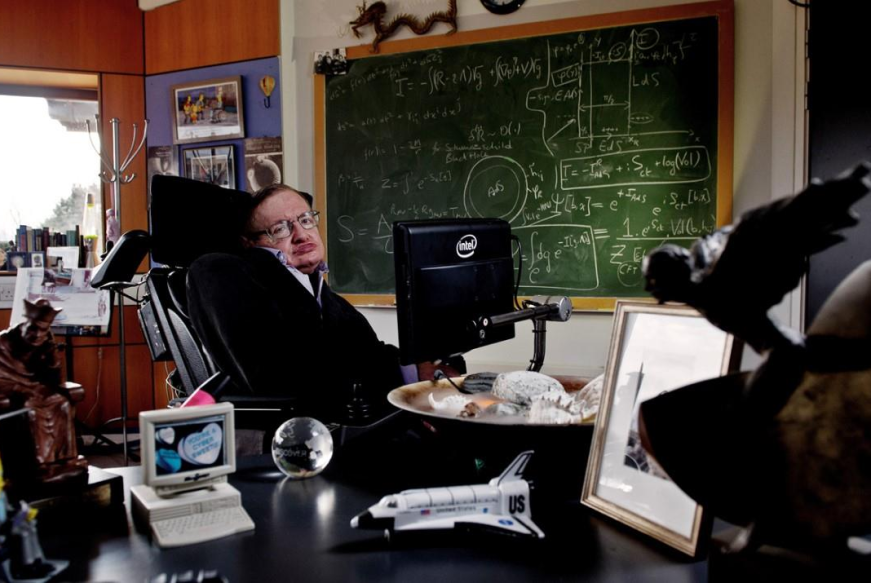
Opening on 9 February, visitors to the National Science and Media Museum can see a new display, Stephen Hawking at Work, exploring the remarkable life of the world-renowned theoretical physicist, following its successful run at the Science Museum in London.
For the first time audiences from outside London will be able to see significant objects up close from Professor Stephen Hawking’s office, which were acquired for the nation by the Science Museum Group in May 2021. These extraordinary objects provide insights into Hawking’s remarkable life as a scientist, science communicator, and as a person who lived with motor neurone disease.
Lucy Hawking commented: “It’s wonderful to see items from my father's office brought together at the National Science and Media Museum as part of a highlights display. Dad’s office was such a unique and fascinating environment, and I hope this display might inspire some scientists of the future.”
In Stephen Hawking at Work, visitors can see Hawking’s rare PhD thesis, his spectacles adapted to aid communication and even an invitation to a party for time travelers which Hawking hosted.
Dr Juan-Andres Leon, Curator of Stephen Hawking at Work, added: “On display for the first time outside of London, visitors to the National Science and Media Museum will be able to explore extraordinary objects from Professor Stephen Hawking’s office. These notable items give a rare glimpse into Hawking’s remarkable life as a world-renowned theoretical physicist to inspire the next generation of scientists and thinkers. The Science Museum Group acquired Hawking’s most treasured possessions in May 2021 and now audiences from across the country will have the opportunity to see a selection of these fascinating objects up close.”
The display contains one of only five known copies of Hawking’s PhD thesis. This significant thesis examined possible solutions to Einstein’s equations of general relativity to demonstrate that the universe must have originated in a singularity, a single point of infinite density. The thesis also provides an early example of Hawking’s clear writing style when dealing with complex ideas - a style which ultimately enabled him to become a compelling communicator of science.
From his bestselling books to his unmissable cameos in popular television shows, Hawking used a huge breadth of channels to inspire and advocate for making complex scientific theories accessible to the wider public. On display is a photograph from the set of Hawking’s guest appearance on Star Trek: The Next Generation, where he was the only person to play themselves in the Star Trek universe.
Stephen Hawking at Work also explores Hawking’s experience of motor neurone disease. Initially given a two-year prognosis when diagnosed, Hawking lived with the disease for more than five decades. From the late 1960s he used a wheelchair and from 1986 Hawking used a voice synthesiser after an emergency tracheotomy meant he could no longer speak. On display is the latest generation of wheelchair used by Hawking: the Permobil F3 model. Jonathan Wood, Hawking’s graduate assistant, noted it was far more than just a wheelchair - it was also his voice, how he communicated his ideas to the world, his ventilation support and his mobile office.
Hawking’s innovative communication systems demonstrate how technology was adapted to accommodate changing needs over the course of his life. Visitors can see Hawking’s earliest voice synthesiser, adapted to hang on the back of his wheelchair and his spectacles which had a cheek sensor to control his voice software.
Visitors across the country will have the opportunity to see these fascinating objects up close as the display tours the Science Museum Group’s museums, opening next at the Science and Industry Museum in Manchester in spring 2023.
Global audiences can explore hundreds of remarkable items from Hawking’s working life as more than 700 items have now been catalogued, photographed and published on the Science Museum Group's popular online collection. A new online article exploring the extraordinary objects from Hawking’s office has also been published, with further articles to follow on.
For more information visit: www.scienceandmediamuseum.org.uk/whats-on/stephen-hawking-work
Related
Comments
Comments are disabled for this post.


 to add an item to your Itinerary basket.
to add an item to your Itinerary basket.





As a reader, I couldn't help but marvel at the artifacts that once surrounded one of the greatest minds of our time. The personal touch, like his handwritten notes and the iconic wheelchair, adds a human element to his extraordinary legacy.
On a related note, I recently came across an interesting online resource: https://calmerry.com/tests/
It offers a variety of tests related to mental health and well-being. I found it quite relevant considering the profound impact individuals like Hawking have had on our understanding of the universe and the importance of maintaining our mental health.
Exploring the link, I stumbled upon some insightful tests that sparked self-reflection and awareness. In a way, it reminded me of how Hawking's work transcended the boundaries of the known, encouraging us to explore not only the outer cosmos but also the inner workings of our minds.
In conclusion, this display is a must-visit for anyone intrigued by the intersection of science and humanity. It's a journey through the tangible remnants of a scientific genius. And who knows, perhaps engaging with resources like calmerry.com/tests can help us appreciate the fragility and resilience of our own minds in the face of the unknown.
Visit Page: https://www.guide4sure.com/NSK200-release.html
Visit :-https://globalassignmentexpert.com/essay-writing-help